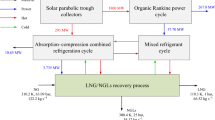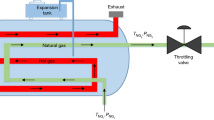Abstract
If the process heat of compound parabolic collector is integrated with an organic Rankine cycle, work output of significant amount from the system can be achieved provided mass flow rate of the organic fluid is properly maintained alongside uncontrollable ambient parameters. In this study, the objective is to analyse the performance of a low-concentration-ratio compound parabolic collector using ANSYS Fluent Computational Fluid Dynamics software and to integrate the same with an organic Rankine cycle engine to assess the thermodynamic performance of the system under very low mass flow rates (0.003–0.009 kg/s), different solar irradiances (300–1000 W/m2) and ambient temperature levels (24–40 °C). In the integrated mode, the organic fluid is passed through the collector, which re-enters the engine after heating. The influences of the rate of mass flow and ambient parameters on the working fluid outlet temperature, collector efficiency and collector heat loss are investigated parametrically for performance assessment of the collector. In the integrated mode, the effects of solar radiation, pressure ratio, working fluid outlet temperature and condenser side temperature on the maximum achievable thermal efficiency and work output are analysed using Engineering Equation Solver and compared with a standard engine. The results reveal that increasing the turbine inlet pressure, decreasing mass flow rate of flow and decreasing the cold side temperature of the turbine could improve system performance. The integrated unit is capable to show maximum efficiency of 13.03%, which is an increase by 3.7% compared with an earlier study of similar system having same working fluid.














Similar content being viewed by others
References
Antonelli M, Baccioli A, Francesconi M, Lensi R, Martorano L (2014) Analysis of a low concentration solar plant with compound parabolic collectors and a rotary expander for electricity generation. Energy Proc 45:170–179
Antonelli M, Baccioli A, Francesconi M, Desideri U, Martorano L (2015) Electrical production of a small size concentrated solar power plant with compound parabolic collectors. Renew Energy 83:1110–1118
Antonelli M, Baccioli A, Francesconi M, Desideri U (2016) Dynamic modelling of a low-concentration solar power plant: a control strategy to improve flexibility. Renew Energy 95:574–585
Arslan O, DamlaKilic (2021) Concurrent optimization and 4E analysis of organic Rankine cycle power plant driven by parabolic trough collector for low-solar radiation zone. Sustain Energy Technol Assess 46:101230
Bellos E, Korres DN, Tzivanidis C (2023) Investigation of a Compound parabolic collector with a flat glazing. Sustainability 15(5):43–47
Bernardo LR, Davidsson H, Karlsson B (2011) Performance evaluation of a high solar fraction CPC collector system. J Environ Eng 6(3):680–692
Buttinger F, Beikircher T, Pröll M, Schölkopf W (2010) Development of a new flat stationary evacuated CPC-collector for process heat applications. Sol Energy 84:1166–1174
Cioccolanti L, Hamedani SR, Villarini M (2019) Environmental and energy assessment of a small-scale solar organic Rankine cycle trigeneration system based on compound parabolic collectors. Energy Convers Manage 198:111829
Ebrahimpour B, Hajialigol P, Boroushaki M, Mohammad BS (2022) Modeling and techno-economic study of a solar reverse osmosis desalination plant. Int J Environ Sci Technol 19:8727–8742
Gang P, Jing Li, Jie Ji (2010) Analysis of low temperature solar thermal electric generation using regenerative organic Rankine Cycle. Appl Therm Eng 30:998–1004
Gang P, Jing Li, Jie Ji (2010) Working fluid selection for low temperature solar thermal power generation with two-stage collectors and heat storage units. In: Manyala R (ed) Solar collectors and panels, theory and applications. IntechOpen, London
Gang P, Jing L, Jie J (2011) Design and analysis of a novel low-temperature solar thermal electric system with two-stage collectors and heat storage units. Renew Energy 36:2324–2333
Garg P, Orosz MS (2018) Economic optimization of organic Rankine cycle with pure fluids and mixtures for waste heat and solar applications using particle swarm optimization method. Energy Convers Manage 165:649–668
Kalogirou SA (2004) Solar thermal collectors and applications. Prog Energy Combust Sci 30(3):231–295
Kumar A, Gupta PR, Tiwari AK, Said Z (2022) Performance evaluation of small scale solar organic Rankine cycle using MWCNT+ R141b nanorefrigerant. Energy Convers Manage 260:115631
Li G (2019) Organic Rankine cycle environmental impact investigation under various working fluids and heat domains concerning refrigerant leakage rates. Int J Environ Sci Technol 16:431–450
Li C, Kosmadakis G, Manolakos D, Stefanakos E, Papadakis G, Goswami DY (2013) Performance investigation of concentrating solar collectors coupled with a transcritical organic Rankine cycle for power and seawater desalination co-generation. Desalination 318:107–117
Liu Z, Ehyaei MA (2022) Thermoeconomic and exergoenvironmental assessments of a combined micro-gas turbine and superheated Kalina cycles for cogeneration of heat and electrical power using biomass. Int J Environ Sci Technol 19:11233–11248
Loni R, Mahian O, Markides CN, Bellos E, le Roux WG, Kasaeian A, Najafi G, Rajaee F (2021) A review of solar-driven organic Rankine cycles: recent challenges and future outlook. Renew Sustain Energy Rev 150:111410
Machado F, Teixeira ACSC, Ruotolo LAM (2023) Critical review of Fenton and photo-Fenton waste water treatment processes over the last two decades. Int J Environ Sci Technol. https://doi.org/10.1007/s13762-023-05015-3
Mazurek AB, Świeboda T, Mazurek W (2011) Performance analysis of a solar-powered organic Rankine cycle engine. J Air Waste Manag Assoc 61(1):3–6
Nasser MA, Almefreji BK, Kim M-H (2021) Thermodynamic performance analysis of solar based organic Rankine cycle coupled with thermal storage for a semi-arid climate. Machines 9:88. https://doi.org/10.3390/machines9050088
Oommen R, Jayaraman S (2001) Development and performance analysis of compound parabolic solar concentrators with reduced gap losses-oversized reflector. Energy Convers Manage 42:1379–1999
Patel D, Patel DK (2015) Thermal analysis of compound parabolic concentrator. Int J Mech Prod 5(6):117–126
Rajaee F, Rad MAV, KasraAliyon AlibakhshKasaeian, Mahian O (2023) Techno-economic evaluation of an organic Rankine cycle-based multi-source energy system for 100%-renewable power supply: a rural case study. Sustain Cities Soc 89:104290
Riaz H, Ali M, Akhtar J, Muhammad R, Muhammad K (2021) Comparative optical and thermal analysis of compound parabolic solar collector with fixed and variable concentration ratio. Eng Proc 12(1):85. https://doi.org/10.3390/engproc2021012085
Roy JP, Mishra MK, Misra A (2011) Performance analysis of an organic Rankine cycle with superheating under different heat source temperature conditions. Appl Energy 88:2995–3004
Samuel N, Srinath A, Sharma N, Tammana AK, Shameer Basha M (2022) Solar organic Rankine cycle—parametric analysis based on exergy vs energy approaches. J Renew Sustain Energy 14:043705
Sherwani AF (2022) Analysis of solar energy driven organic Rankine cycle-vapor compression refrigeration system. Therm Sci Eng Prog 35:101477
Sonsaree S, TatsunoriAsaoka SJ, Aguirre H, Tanaka K (2018) A small-scale solar organic Rankine cycle power plant in Thailand: three types of non-concentrating solar collectors. Sol Energy 162:541–560
Tiwari D, Sherwani AF, Atheaya D, Arora A (2017) Energy and exergy analysis of solar driven recuperated organic Rankine cycle using glazed reverse absorber conventional compound parabolic concentrator (GRACCPC) system. Sol Energy 155:1431–1442
Tiwari D, Sherwani AF, Atheaya D, Kumar A, Kumar N (2020) Thermodynamic analysis of organic Rankine cycle driven by reversed absorber hybrid photovoltaic thermal compound parabolic concentrator system. Renew Energy 147:2118–2127
Tiwari D, Atheaya D, Kumar A, Kumar N (2022) Analysis of organic rankine cycle powered by N-number of solar collectors in series. Energy Sour Part a Recovery Util Environ Eff 44(3):6678–6697
Ustaoglu A, Okajima J, Zhang X-R, Maruyama S (2019) Assessment of a solar energy powered regenerative organic Rankine cycle using compound parabolic involute concentrator. Energy Convers Manage 184:661–670
Zhao W, Xie N, Zhang W, Yue J, Wang L, Xianbiao Bu, Li H (2021) Performance characteristics and working fluid selection for high-temperature organic Rankine cycle driven by solar parabolic trough collector. Int J Low-Carbon Technol 16(4):1135–1149
Author information
Authors and Affiliations
Corresponding author
Additional information
Editorial responsibility: Maryam Shabani.
Rights and permissions
Springer Nature or its licensor (e.g. a society or other partner) holds exclusive rights to this article under a publishing agreement with the author(s) or other rightsholder(s); author self-archiving of the accepted manuscript version of this article is solely governed by the terms of such publishing agreement and applicable law.
About this article
Cite this article
Bhaumick, A., Sengupta, A.R., Biswas, A. et al. Performance of compound parabolic collector integrated with organic Rankine cycle under low mass flow rates for clean energy. Int. J. Environ. Sci. Technol. (2024). https://doi.org/10.1007/s13762-024-05605-9
Received:
Revised:
Accepted:
Published:
DOI: https://doi.org/10.1007/s13762-024-05605-9




